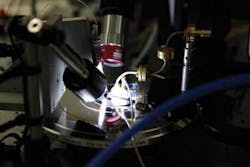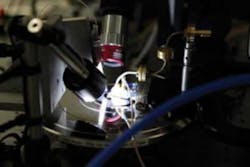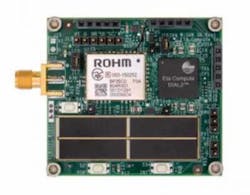Courtesy of Tektronix
Tektronix Inc. and IEMN, a French research laboratory, have demonstrated a single-carrier wireless link traveling at a 100-Gb/s data rate. This demonstration uses advanced data coding, THz photonics, and wideband and linear devices to enable ultrafast wireless connections in the 252- to 325-GHz band per the recently published IEEE 802.15.3d standard.
“Achieving 100-Gb/s transmission in a single carrier helps to fill the gap between the worlds of fiber-optics and radio. By combining the concept with dedicated architectures and photonic-based THz circuits we are paving the way for far faster wireless transmission than what’s possible today,” said Guillaume Ducournau, an associate professor at IEMN/CNRS/University Lille working on THz communication systems.
15-year-old digitizer cards play vital role at DESY
Spectrum Instrumentation announced that it has become one of DESY’s suppliers of choice for digitizer cards for the past fifteen years. DESY, short for Deutsches Elektronen-Synchrotron, is based in Hamburg, Germany, and operates particle accelerators to investigate the structure of matter. The accelerators run 24/7.
“Spectrum’s products have certainly proven themselves to be reliable,” said Mark Lomperski, staff scientist at DESY. “The first digitizer cards that we bought for our group more than 15 years ago are still in use today, happily sampling away. These Spectrum MI.3132s are used to measure the power in the RF pulses in the Linac-2 accelerator, which has 12 RF stations, each producing 5-ms RF pulses of 20 MW at 50 Hz, and the cards sample at 25 MHz. The digital inputs of the MI.3132s provide an elegant method to ‘tag’ each RF pulse with information from the central timing system for use in my detailed analysis. These cards are used to monitor the ‘health’ of the technical systems, from pulse-to-pulse and over a period of years.”
MIPI and VESA team up to enable high-quality mobile video
The MIPI Alliance announced it has teamed up with the Video Electronics Standards Association (VESA) to address the need for visually lossless video compression—with a focus on mobile-use cases such as smartphones, tablets, AR/VR headsets, and connected cars. The MIPI Alliance has released new versions of MIPI Display Serial Interface 2 (DSI-2) and MIPI Display Command Set (DCS). Both new specifications support VESA Display Compression-M (VDC-M), a new display interface compression standard specifically designed for the handheld display market.
MIPI DSI-2 v1.1 specifies the physical link between the chip and display in devices such as smartphones, tablets, AR/VR headsets, and connected cars. MIPI DCS v1.4 specifies display functions such as resolution, width, and brightness that are transmitted over MIPI DSI-2 v1.1.
The VDC-M standard provides up to 5:1 compression with no visible effect on video quality and a corresponding reduction in power consumption. The combination of VDC-M and MIPI DSI-2 and DCS helps systems designers minimize device cost and complexity, maximize battery life, and deliver the high-resolution video content that customers seek.
Sensors Expo highlights sensor nodes, IoT and embedded portfolios
Sensors Expo & Conference took place June 26-28 in San Jose, CA, with conference tracks spanning technologies from energy harvesting to optical sensing. The conference was accompanied by four preconference symposia and two co-located events, Autonomous Vehicle Sensors Conference and Medical Sensors Design Conference.
On the exhibit floor, Eta Compute Inc. and ROHM Semiconductor highlighted a collaborative effort to develop low-power Wireless Smart Ubiquitous Network (Wi-SUN)-compatible sensor nodes. The nodes combine ROHM’s sensor technology and Eta Compute’s low-power MCUs to deliver low-power solutions for smart utility networks and the IoT. Each company demonstrated an evaluation board with ROHM’s BP35C0 WI-SUN module and Eta Compute’s low-power MCU based on its proprietary DIAL technology.
The nodes coming from the ROHM and Eta Compute partnership will be designed for frequent, low-latency communication that draws less than 1 μA when resting and only 1 mA while sensing. Wi-SUN technology is based on the IEEE 802.15.4g standard and backed by the Wi-SUN Alliance.
In addition, Sensera’s MicroDevices division demonstrated its core expertise in MEMS-based technologies and its ability to bring custom microfabricated, sensor-based devices from concept to market, in applications including in vivo medical products, microfluidic structures for analytics and organ on chip (OoC) applications, and devices for industrial applications. And Sensera’s nanotron Technologies division, a provider of location-awareness solutions, showcased its latest swarm bee modules, which it describes as the first common platform for both UWB and Chirp technologies.
The distributor Rutronik Inc. also exhibited, highlighting its comprehensive portfolio of products and technologies for IoT and embedded systems. The company focused on automotive, industrial, and medical applications.
Organizers announced several “Best of Sensors Expo” awards, including Gold Level awards to STMicroelectronics for its VL53L1X ToF sensor and to ROHM for its next-generation optical PPG sensors. In addition, Quanergy cofounder Tianyue Yu was recognized with the Women in Sensors Engineering (WISE) award for her involvement in the design and launch of the Quanergy S3 solid-state lidar sensor.
Leti demonstrates waveform for 5G low-power wide-area IoT networks
Leti announced that field trials of its new low-power wide-area (LPWA) technology, employing a waveform tailored for IoT applications, showed significant performance gains in coverage, data-rate flexibility, and power consumption compared with other LPWA technologies.
Leti’s LPWA approach includes its patented Turbo-FSK waveform, a flexible approach to the physical layer. It also relies on channel bonding, the ability to aggregate noncontiguous communication channels to increase coverage and data rates. The field trials confirmed the benefits of Leti’s LPWA approach in comparison to LoRa and NB-IoT, two leading LPWA technologies that enable wide-area communications at low cost and long battery life.
“Leti’s Turbo-FSK receiver performs close to the Shannon limit, which is the maximum rate that data can be transmitted over a given noisy channel without error, and is geared for low spectral efficiency,” said Vincent Berg, head of Leti’s Smart Object Communication Laboratory. “Moreover, the waveform exhibits a constant envelope—that is, it has a peak-to-average-power ratio (PAPR) equal to 0 dB, which is especially beneficial for power consumption. Turbo-FSK is therefore well adapted to future LPWA systems, especially in 5G cellular systems.”
Virtual collaboration accelerates product lifecycle at Raytheon
Virtalis has announced that Raytheon is harnessing the collaborative power of Virtalis’s Visionary Render VR software as one solution to virtually collaborate across the entire product lifecycle.
The Raytheon Missile Systems Immersive Design Center’s manager, Kendall Loomis, explained, “Our best results happen when we bring diverse, cross-functional people together in our visualization theater, which can hold up to 70 people. We include folks outside the design world, like software and industrial engineers to operators and testers, and through the power of large-scale visualization they are able to see opportunities to reduce risk and cost. They ask questions like, ‘Where can I put my torque wrench,’ or ‘Is that a clearance issue?’ The visualization empowers folks across all platforms, from supply chain to quality—it focuses the conversation.”
imec demonstrates efficient, cost-effective cooling for high-performance chips
imec announced that it has demonstrated a low-cost impingement-based solution for cooling chips at package level. The organization said this achievement is an important innovation to tackle the ever-increasing cooling demands of high-performance 3D chips and systems.
“Our new impingement chip cooler is actually a 3D-printed ‘showerhead’ that sprays the cooling liquid directly onto the bare chip,” explained Herman Oprins, senior engineer at imec. “3D prototyping has improved in resolution, making it available for realizing microfluidic systems such as our chip cooler. 3D printing enables an application-specific design, instead of using a standard design.” EE
About the Author

Rick Nelson
Contributing Editor
Rick is currently Contributing Technical Editor. He was Executive Editor for EE in 2011-2018. Previously he served on several publications, including EDN and Vision Systems Design, and has received awards for signed editorials from the American Society of Business Publication Editors. He began as a design engineer at General Electric and Litton Industries and earned a BSEE degree from Penn State.





